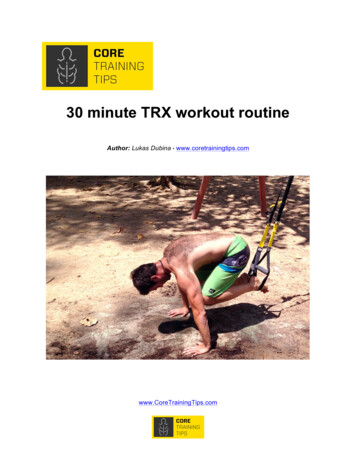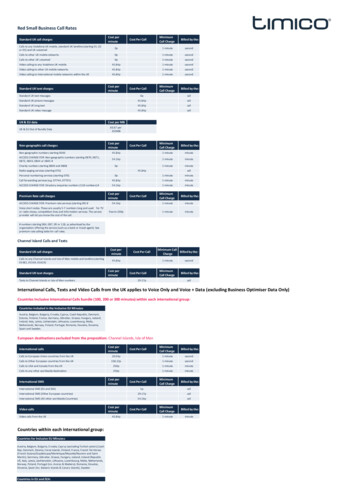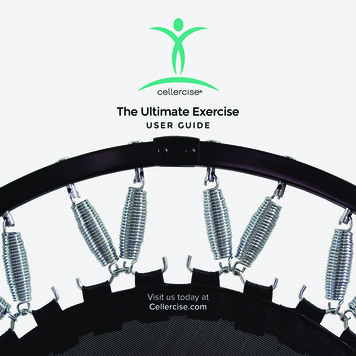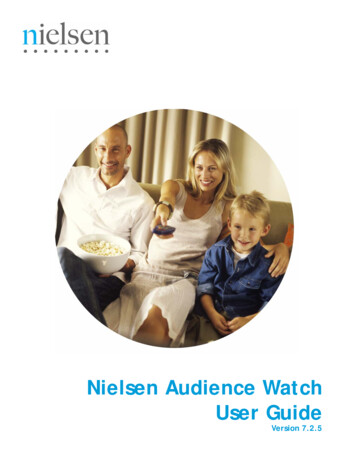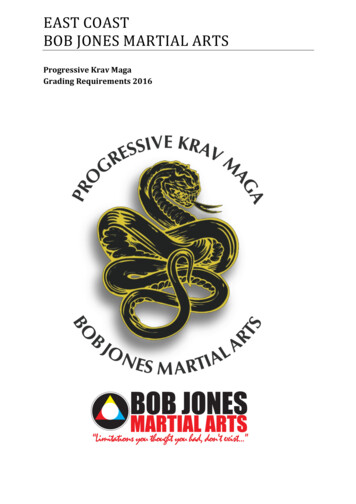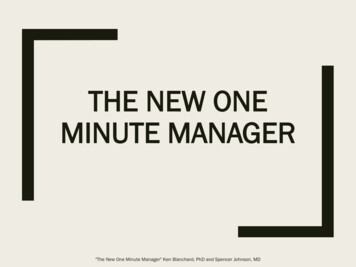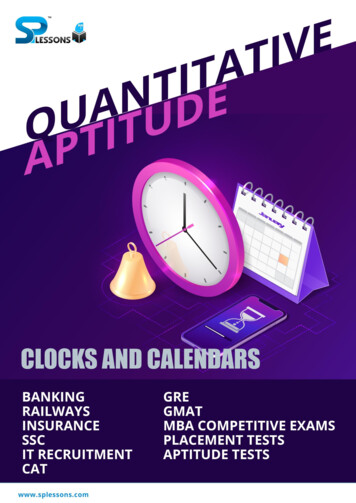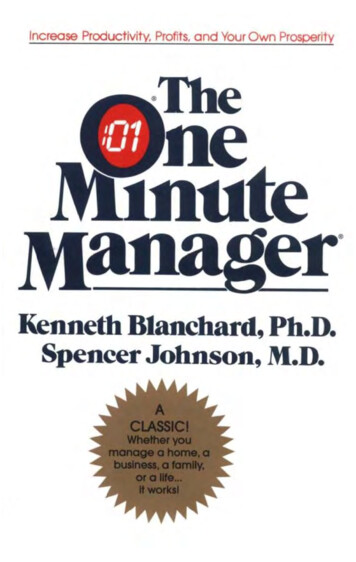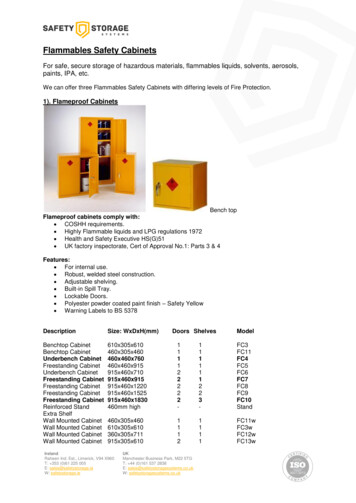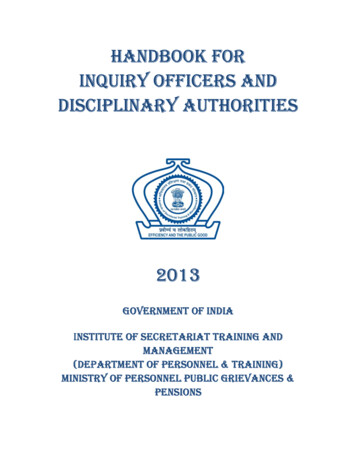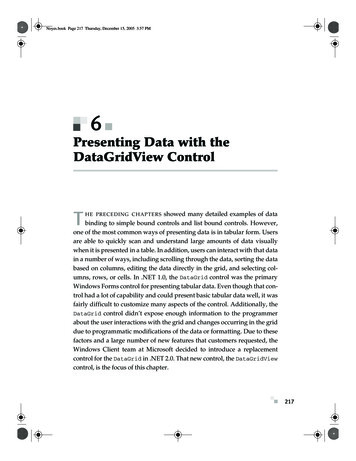
Transcription
Presenting a live 90-minute webinar with interactive Q&AMedicaid Crisis Planning:Advanced Techniques for PreservingAssets After Nursing Home AdmissionLeveraging DRA Promissory Notes, Community Spouse ResourceAllowance and Medicaid Qualified AnnuitiesWEDNESDAY, OCTOBER 22, 20141pm Eastern 12pm Central 11am Mountain 10am PacificToday’s faculty features:Marty Burbank, J.D., LL.M., Attorney, Law Office of Marty Burbank, Fullerton, Calif.Joley L. Eason, ThompsonMcMullan, Richmond, Va.David Goldfarb, Managing Partner, Goldfarb Abrandt Salzman & Kutzin, New YorkThe audio portion of the conference may be accessed via the telephone or by using your computer'sspeakers. Please refer to the instructions emailed to registrants for additional information. If youhave any questions, please contact Customer Service at 1-800-926-7926 ext. 10.
Tips for Optimal QualityFOR LIVE EVENT ONLYSound QualityIf you are listening via your computer speakers, please note that the qualityof your sound will vary depending on the speed and quality of your internetconnection.If the sound quality is not satisfactory, you may listen via the phone: dial1-866-961-9091and enter your PIN when prompted. Otherwise, pleasesend us a chat or e-mail sound@straffordpub.com immediately so we canaddress the problem.If you dialed in and have any difficulties during the call, press *0 for assistance.Viewing QualityTo maximize your screen, press the F11 key on your keyboard. To exit full screen,press the F11 key again.
Continuing Education CreditsFOR LIVE EVENT ONLYFor CLE purposes, please let us know how many people are listening at yourlocation by completing each of the following steps: In the chat box, type (1) your company name and (2) the number ofattendees at your location Click the SEND button beside the boxIf you have purchased Strafford CLE processing services, you must confirm yourparticipation by completing and submitting an Official Record of Attendance (CLEForm).You may obtain your CLE form by going to the program page and selecting theappropriate form in the PROGRAM MATERIALS box at the top right corner.If you'd like to purchase CLE credit processing, it is available for a fee. Foradditional information about CLE credit processing, go to our website or call us at1-800-926-7926 ext. 35.
Program MaterialsFOR LIVE EVENT ONLYIf you have not printed the conference materials for this program, pleasecomplete the following steps: Click on the symbol next to “Conference Materials” in the middle of the lefthand column on your screen. Click on the tab labeled “Handouts” that appears, and there you will see aPDF of the slides for today's program. Double click on the PDF and a separate page will open. Print the slides by clicking on the printer icon.
Medicaid Spend “UP”Marty Burbank, JD, LLMLaw Office of Marty BurbankFullerton, CA 92832www.OCElderLaw.commarty@ocelderlaw.com
Spend Down vs. Spend Up Traditional Information from DischargePlanners and Skilled Nursing Social Workers is:Your parents will have to spend down thereassets on care before they are eligible forMedicaid. After paying for care for severalmonths or more than a year, when all of theirwealth has been depleted then they willqualify for Medicaid.6
Problem with Spend DownPreserves no assets for the unforeseen needs ofthe senior institutionalized client, or the wellspouse of an institutionalized client.7
Converting Countable Assets toNon-Countable AssetsSpending Up Countable Assets can Be converted into noncountable or non available assets and aperson can be immediately qualified forMedicaid without penalty.8
Countable or Available Assets CashMarketable SecuritiesReal Estate Other than a HomeMore than one carJewelrySavings BondsLife Insurance9
Non-Countable AssetsNon-CountableHome of Any Value (depending on state)Car of Any ValueMusical InstrumentsHousehold FurnishingsFuneral ArrangementsMedicaid Qualified Annuity10
Spend UP -- Strategies If there is debt, Pay down mortgageBuy a home or even party of a child’s homeDeferred maintenance on homeUpdate: Kitchen, Roof, Bathrooms, etc.Buy a new or newer carSet aside funds for funeralBuy Long Term Care Insurance11
Benefits of Spending Up Accelerated Eligibility Preserved Assets for Well Spouse Created a Better Quality of Life for WellSpouse. If pre need planning then both spouses canbenefit from updated house and car Funeral arrangements are taken care of12
Wealth Preservation Advanced Strategies are now available toavoid Medicaid Recovery and transfer wealthto the children or other beneficiaries.13
Outright Gifting There is no penalty period for gifts of exemptassets. Transfers to Adult Responsible Children Transfers to Irrevocable Trust Eligibility for Medicaid and VA Benefits14
Irrevocable Trusts forMedicaid PlanningMarty Burbank, JD, LLMLaw Office of Marty BurbankFullerton, CA 92832www.OCElderLaw.commarty@ocelderlaw.com
VA and Medicaid Veterans Asset Protection(VAP) Trusts Medicaid Asset Protection(MAP) Trusts16
Veterans PensionAid and Attendance Aid & Attendance Benefits are available towar era veterans and their surviving spouseswho require the regular attendance ofanother person to assist in at least twoactivities of daily living such as eating,bathing, dressing and undressing, transferringand the needs of nature Can be at Home, Assisted Living, or SNF17
Veterans PensionAid and Attendance Benefits:– Single Veteran– Married Veteran– Surviving Spouse of Veteran– Both Spouses are Vets 1,758 2,085 1,130 2,78818
MedicaidLong Term Care Generally provides only for care in a SkilledNursing Facility (SNF) although some stateshave programs that provide funding froassisted living. Patient pays a share of cost and stateguarantees balance to give the SNF the totalequal to the Average Private Pay Rate19
VA Service Qualifications War Time Veteran– One Day during time of war WWIWWIIKoreaVietnamWar on Terror 90 days consecutive service Honorable discharge20
Asset QualificationsGenerally Less Than 80,000– Countable CashMarketable SecuritiesReal Property other than HomeIRA, 401(k), 403(b)– Not Countable HomeCareFurnishingsFuneral Arrangements21
VA Income Qualification Income must be less than:– Single Veteran– Married Veteran– Surviving Spouse 1,733/mo 2,054/mo 1,114/mo22
Income for VA Purposes(IVAP) All Countable Income less Out of PocketMedical Expenses IVAP23
Example 1Sammy Seal Served 2 years in the Navy in CoronadoCalifornia. He started his service in December8th 1939 and was discharged December 9th,1941. He has income from his teachers pension of 4000 per month. His expenses for assistedliving total 5500 per month his IVAP is 024
Example 1 cont. Income Out of Pocket Exp. IVAP 4000- 5,500 025
Example 2Freddie Frogman Served from December 8 1942 to Jan 1, 1955. Eniwetok, Saipan, Guam, Tinian, Angaur,Ulithi, Pelilui, Leyte, Lingayen Gulf, Zambales,Iwo Jima, Okinawa, Labuan, Brunei Bay, andBorneo, Inchon, Wonsan Harbor, Hungnam. Lives in assisted living and rents out his home.He as a pension from the carpenter’s union.26
Example 2Freddie Frogman Cont.Rental IncomePension IncomeSocial SecurityTotalOut of Pocket Medical Exp.Income for IVAP 2000 4000 1200 7200- 5500 170027
VA - Asset Protection Trust Qualify for VA Pension with Aid andAttendance Protect from the Creditors of the Beneficiary Protect from Capital Gains Taxes Protect from Spendthrift Beneficiaries Protect Special Needs Beneficiaries28
Medicaid Issues Qualification Share of Cost Medical Recovery29
Medicaid Qualification Single– Countable Assets less than 2000 Married with community spouse– Community Spouse Resource Allowance 117,24030
Share of Cost Minimum Monthly Maintenance needsAllowance– 2,93131
Medicaid Penalty In most states there is a 60 month look backpenalty that will assign a penalty for any giftsmade in the previous 60 months. (notCalifornia) Penalty is calculated by dividing the amount ofthe gift by the average private pay rate of anursing home. (about 7500) The quotient, rounded down, is the number ofmonths of ineligibility.32
Virginia Puller Gifts 80,000 to grandson in January of 2014. 7500/80,000 10.6666 Round down to give us Virginia a penalty of 10months. Applies for benefits January of 2015. In most states she will have to wait until 10months (November 2015) after herapplication for Medicaid before she will beeligible for benefits.33
Some Tax Issues Capital Gains Tax Step Up IRC 1014 Capital Gains Home Exclusions IRC 121 250,000/ 500,00034
One Approach is Outright Gifting Transfer Assets to Adult ChildrenLoss of Step Up IRC 1014Loss of 250,000/ 500,000 Exclusion IRC 121Risk from Beneficiary’s CreditorsMultiple Beneficiary IssuesLack of Spendthrift and SNT options35
Better ApproachIrrevocable TrustGet Step up at Death121 ExclusionProtected from Creditors of BeneficiaryIncome generated by trust assets can be excludedfrom Share of Cost Trust Assets are Protected from MedicaidRecovery SNT and Spendthrift Provisions for Beneficiariespossible 36
Medicaid Asset Protection Trust Protect Assets from Medicaid RecoveryProtect from the Creditors of the BeneficiaryProtect from Share of CostProtect from Capital Gains TaxesProtect from Spendthrift BeneficiariesProtect Special Needs Beneficiaries37
Grantor Trust Issues for VA Grantor Trust Status May Cause Income to Beattributed to the grantor which can cause theVA to wrongly deny benefits based onphantom income attributed to the grantor. For VA cases we do one non-grantor trust forall assets other than home. For the Home in a grantor trust.38
Thank YouMarty Burbank, JD, LLMmarty@ocelderlaw.com39
Advance Techniques for Preserving Assets AfterNursing Home AdmissionJoley L. EasonThompsonMcMullanRichmond, VA
Leveraging the Community SpouseResource AllowanceConversion of countable assets toexempt assets41
Medicaid law provides for special protectionsfor the spouse of a nursing home resident/Waiver recipient.“Community Spouse” &“Institutionalized Spouse”42
Community spouse is permitted to keep 100% ofthe couple’s combined assets, up to the minimumCommunity Spouse Resource Allowance (CSRA).Community Spouse is permitted to keep 50% of thecouple’s combined assets, up to the maximumCommunity Spouse Resource Allowance.43
Community Spouse Minimum Resource Allowance 23,448 Maximum Resource Allowance 117,240Institutionalized Spouse (single or married) Maximum Resource Allowance 2,00044
SNAPSHOT DATE Date that Medicaid uses to determine the totalcountable assets for purposes of calculating theCommunity Spouse Resource Allowance.Resource assessment as of first day of the monthof institutionalization of the nursing homespouse in the hospital or long-term care facilitywith subsequent 30-day stay. (If notinstitutionalized, use date Medicaid determinedthe individual met medical requirements.)45
It is advantageous for the couple to have as muchmoney as possible in their names on the snapshotdate up to 234,480 ( 117,240 x 2) so that theamount the community spouse is allowed to keepwill be as high as possible.46
After the institutionalized spouse qualifies forMedicaid long-term care assistance, thecommunity spouse’s resources are no longerdeemed available to the institutionalized spouse.47
117,240 in Virginia If countable assets have value of more than 234,480 ( 117,240 x 2) Allocate tax-free assets to CS If countable assets have value of less than 234,480 ( 117,240 x 2) Borrow before snapshot date to increase thecommunity spouse resource allowance Home equity loan Personal loan (eg from family member)48
Jim and Jane have 150,000 in countableassets. Jane’s Community Spouse Resource Allowance 75,000 Jim’s Resource Allowance 2,000 Excess: 73,000 Remaining excess toward exempt assets, other debts49
Jim and Jane had 150,000 in countableassets.By borrowing 80,000 before the snapshotdate, their net worth increases to 230,000. Jane’s Community Spouse Resource Allowance 115,000 Jim’s Resource Allowance 2,000 Excess: 112,000 Use 80,000 to repay loan after snapshot date Remaining excess toward exempt assets, other debts50
This strategy resulted in an additional 40,000 in protected assets for theCommunity Spouse.51
Transfer home to Community SpouseTransfer all other assets to CommunitySpouseDraft new Last Will and Testament forCommunity Spouse that includes a SpecialNeeds Trust for the Institutionalized Spouse(VA- elective share requirement)52
Community spouse is permitted to keep 100% of his/herincome, and will not have to use his/her income to supportthe institutionalized spouse.Community Spouse is also entitled to a share of theinstitutionalized spouse’s income if his/her own income fallsbelow the Minimum Monthly Maintenance Needs Allowance(MMMNA).Community Spouse may be able to keep an additional shareof the institutionalized spouse’s income if they have excessshelter expenses (certain calculations apply).53
Community Spouse Income Allowance Minimum Monthly Maintenance Needs Allowance 1,938 Maximum Income Allowance 2,931Institutionalized Spouse Personal Needs Allowance(if available after patient pay deductions) Waiver Recipients- 1,186Skilled Nursing Facility Residents- 4054
PurchasePurchasePurchasePurchasePurchasePurchaseor upgrade principal residenceor upgrade vehiclehousehold furnishingsirrevocable funeral plan & burial plotlife estate (12 month residency required in VA)savings bonds (up to 20,000/yr per person)55
Purchase Medicaid-qualifying annuity in thename of the Community SpousePurchase Medicaid-qualifying promissorynote in the name of the Community Spouse56
Thank you for your time and attention!Joley L. EasonThompsonMcMullan100 Shockoe SlipRichmond, VA 2319(804) 698-5934jeason@t-mlaw.com57
Medicaid Crisis PlanningDavid GoldfarbGoldfarb Abrandt Salzman & Kutzin LLP350 Fifth Ave. Suite 4310New York, NY 10118www.seniorlaw.comgoldfarb@seniorlaw.comV. Deficit Reduction Act qualifiedpromissory notesVI. Medicaid qualified annuities
Medicaid Crisis PlanningDeficit Reduction Act qualifiedpromissory notes59
Transfer of Asset Rules The Social Security Act was amended regardingtransfers of assets effective February 8, 2006, bythe Deficit Reduction Act of 2005 (DRA '05) andthe Tax Relief and Health Care Act of 2006. The federal provisions for liens, adjustments andrecoveries, and transfers of assets are codified at42 USC § 1396p. Most state’s rules did not change until enablinglegislation or regulations were enacted.60
Transfer of Asset Rules Federal law requires a state plan to impose a transfer of assetspenalty for institutionalized individuals, but the state has anoption to impose a penalty on non-institutionalizedindividuals. 42 USC § 1396p(c)(1)(A). Usually, a transfer of asset penalty will not apply to care,services, and supplies provided as part of a waivered programunder Section 1915(c) of the Social Security Act. Transfers between spouses are exempt and no penaltyperiod is imposed. Prior to the application for Medicaid coverage of nursingfacility services, nonexempt transfers by either spouse tothird parties are attributed to the Medicaid applicant, who issubject to any resulting penalty periods.61
Transfer of Assets & MAGI Medicaid CMS has concluded that the transfer rules doapply to MAGI individuals who meet thedefinition of "institutionalized individuals.“ CMSState Medicaid Director Letter 14-001(02/21/2014) ownloads/SMD-14-001.pdf. Since MAGI individuals do not include personsdisabled or 65 years of age and over, it will berare cases where MAGI individuals qualify asinstitutionalized individuals.62
Transfer of Assets & Look Back When a person transfers assets and then receivesor applies for Medicaid-covered nursing facilityservices, the local agency "looks back" atfinancial transactions made within a certainperiod of time from the first date on which theperson was institutionalized and applied forMedicaid coverage that includes nursing facilityservices. Under DRA '05, the look back is 60 months forany disposal of assets made on or after the dateof enactment (February 8, 2006).63
Transfer Penalty A penalty period of ineligibility will beimposed on transfers that are not exempt. The formula for calculating the penalty periodis simple: divide the total amount of assetstransferred for less than fair market value bythe average monthly private pay rate of anursing home in the area where the client isreceiving nursing facility services.64
When Transfer Penalty Begins Under DRA '05, the penalty period for transfers madeon or after February 08, 2006, begins– the first day of the first month during or after which assetshave been transferred,– or the date on which the individual is eligible forMedicaid and would otherwise be receiving institutionalcare based on an approved application but for theapplication of the penalty period,– whichever is later,– and which does not occur in any other period ofineligibility. 42 USC § 1396p(c)(1)(D)(ii)65
When Transfer Penalty Begins Penalties for transfers made after February 8, 2006,don't begin to run until the applicant/recipient is– in a nursing home,– has exhausted all non exempt resources,– and is "otherwise" Medicaid eligible. In other words, if a transfer has been made within thefive year look back, the applicant who has made atransfer will under usual circumstances face a penaltybased on that transfer once she has exhausted nontransferred funds.66
Transfer of Assets & Promissory Notes The transfer of assets under DRA '05 includesfunds used to purchase a promissory note, loanor mortgage UNLESS the note, loan or mortgage:– (1) has a repayment term that is actuarially sound;– (2) has equal repayments during the term of theloan, with no deferral or balloon payments;– (3) prohibits cancellation upon death of the lender. 42 USC § 1396p(c)(1)(I).67
Actuarially Sound Actuarially sound will be determined inaccordance with actuarial publications of theOffice of the Chief Actuary of the SocialSecurity Administration.68
Rule of Halves after DRA ‘05 After DRA ’05 an But, a similar planningindividual can no longertechnique is availabletransfer assets and useunder DRA 2005, byother funds to wait outcombining a transfera penalty periodwith an actuariallybecause he would notsound annuity or loan.be "otherwise" eligible,by virtue of the retainedfunds.69
Gift & Loan At the time of the transfer the institutionalizedperson would have to make a loan (or purchasean annuity), so that funds are not retained andshe is otherwise eligible for Medicaid. The institutionalized person's monthly income,including loan (or the annuity) repayment, wouldhave to render her Medicaid eligible, but shecould not actually receive Medicaid institutionalservices during the penalty period from thetransfer.70
Gift & Loan The shortfall for the nursing home payment couldbe made by an in-kind voluntary contributionfrom a non-legally responsible relative; or alternatively the individual's income could bebetween the Medicaid rate and the private payrate at the facility, rendering her a "certainmedicaid-eligible individual" (individuals whoare otherwise entitled to Medicaid in the facilitybut such benefits are not being paid because,their income exceeds the Medicaid level). 42 USC§ 1396r(c)(7)(A); 42 CFR § 447.20.71
Promissory Note: Possible Issues Although under the DRA the making a loan ormortgage (or purchase of an annuity) may notbe considered a transfer; nevertheless the promissory note (or annuity)may be given a value as a resource eventhough they are drafted as "non-assignable." There is some question whether a note (orannuity) can be made non-assignable undersome state laws. See UCC §§ 9-406.72
Sable v. Velez Sable v. Velez, 437 Fed. Appx. 73, 76 (3d Cir. N.J. 2011) In order to show a likelihood of success on the merits, the plaintiffsmust establish that it was improper for the agencies to consider thenotes as trust-like devices. To qualify as a "cash loan" under the SSI POMS, the instrumentmust be a "negotiable, bona fide loan agreement." §1120.220(B)(2)(a). An informal loan may be bona fide if :–––––(1) it is enforceable under state law,(2) was in effect at the time the cash proceeds were provided,(3) there is an acknowledgment of an obligation to repay,(4) there is a plan for repayment, and(5) the repayment plan is feasible. Id. § 1120.220(C).73
Sable v. Velez The POMS defines trust-like devices as instruments which involve––––(1) a grantor(2) who transfers property(3) to a person or entity with fiduciary obligations(4) with the intention that it be held, managed, or administered bythe person or entity for the benefit of the grantor or others. Id. §§ 1120.201 (B)(5) & (G)(1). “We conclude that the plaintiffs have not met the burden ofshowing that it was more likely than not that a fiduciaryrelationship did not exist between the parents and children.” “Considering that loans between parents and children generally aremade in an environment of trust and confidence, the evidencepresented did not demonstrate that the notes were createdwithout any understanding that the children would simply holdthe money for the benefit of the parents.”74
Medicaid Crisis PlanningMedicaid qualified annuities75
Annuities Use Annuities in Situations Where an Income StreamMay Be More Beneficial than Holding a Non-ExemptResource. The purchase of a single premium immediate annuitywith a guarantee pay-out period based on thepurchaser's life expectancy, will convert resources intoincome. To the extent that the anticipated return iscommensurate with the money invested, purchase ofan insurance company or private annuity is considereda compensated transfer of assets.76
Purchase of an Annuity Under DRA '05, the purchase of an annuity is treated as atransfer for less than fair market value, UNLESS the annuitymeets the following criteria:(1) it names the State as the first remainderbeneficiary for at least the total amount of medicalassistance paid on behalf of the institutionalized individualor the second remainder beneficiary after a communityspouse or minor or disabled child;(2) it is irrevocable and non-assignable;(3) it is actuarially sound;(4) it provides for equal payments during the term withno deferral or balloon payment.42 USC §§ 1396p(c)(1)(F) and (c)(1)(G)77
Annuities and Retirement Plans If annuitizing a retirement plan, make sure that itfalls under the Internal Revenue Code sectionslisted in the statute. The provisions (2) through (4) do not apply toannuitizing certain qualified retirement plans, anIRA or a Roth IRA. 42 USC §§ 1396p(c)(1)(G)(i)(I)and (c)(1)(G)(i)(II). Even so, the restrictions in (1) above--naming thestate as a remainder beneficiary--may apply, ifunder the plan there are remainder beneficiariesafter the annuitant or his spouse.78
Annuity: Income and not Resource Lopes v. Dep't of Soc. Servs., 696 F.3d 180 (2dCir. 2012). The Second Circuit Court of Appeals upheldthe District Court for the District ofConnecticut, finding that a non-assignableannuity provides an income stream whichshould be treated as income and not as aresource.79
Gift and Annuity Planning technique is available under DRA 2005, by combining atransfer with an actuarially sound annuity. At the time of the transfer the institutionalized person would haveto purchase an annuity, so that funds are not retained and she isotherwise eligible for Medicaid. The institutionalized person's monthly income, including theannuity or loan repayment, would have to render her Medicaideligible, but she could not actually receive Medicaid during thepenalty period from the transfer. The individual's income could be between the Medicaid rate andthe private pay rate at the facility, rendering her a "certainmedicaid-eligible individual" (individuals who are otherwiseentitled to Medicaid in the facility but such benefits are not beingpaid because, their income exceeds the Medicaid level). 42 USC §1396r(c)(7)(A); 42 CFR § 447.20.80
Annuities: Possible Issues Although under the DRA the purchase of an annuity,(or making a loan or mortgage) may not be considereda transfer; nevertheless the annuity (or promissory note) may begiven a value as a resource even though they aredrafted as "non-assignable." There is some question whether an annuity (or a note)can be made non-assignable under some state laws.See UCC §§ 9-406. But see James v. Richman, 547 F.3d 214 (3d Cir. 2008)which finds non-assignable annuity purchased bycommunity spouse to have no value as a resource.81
You may obtain your CLE form by going to the program page and selecting the appropriate form in the PROGRAM MATERIALS box at the top right corner. If you'd like to purchase CLE credit processing, it is available for a fee. For additional information about CLE credit processing, go to our website or call us at 1-800-926-7926 ext. 35.
